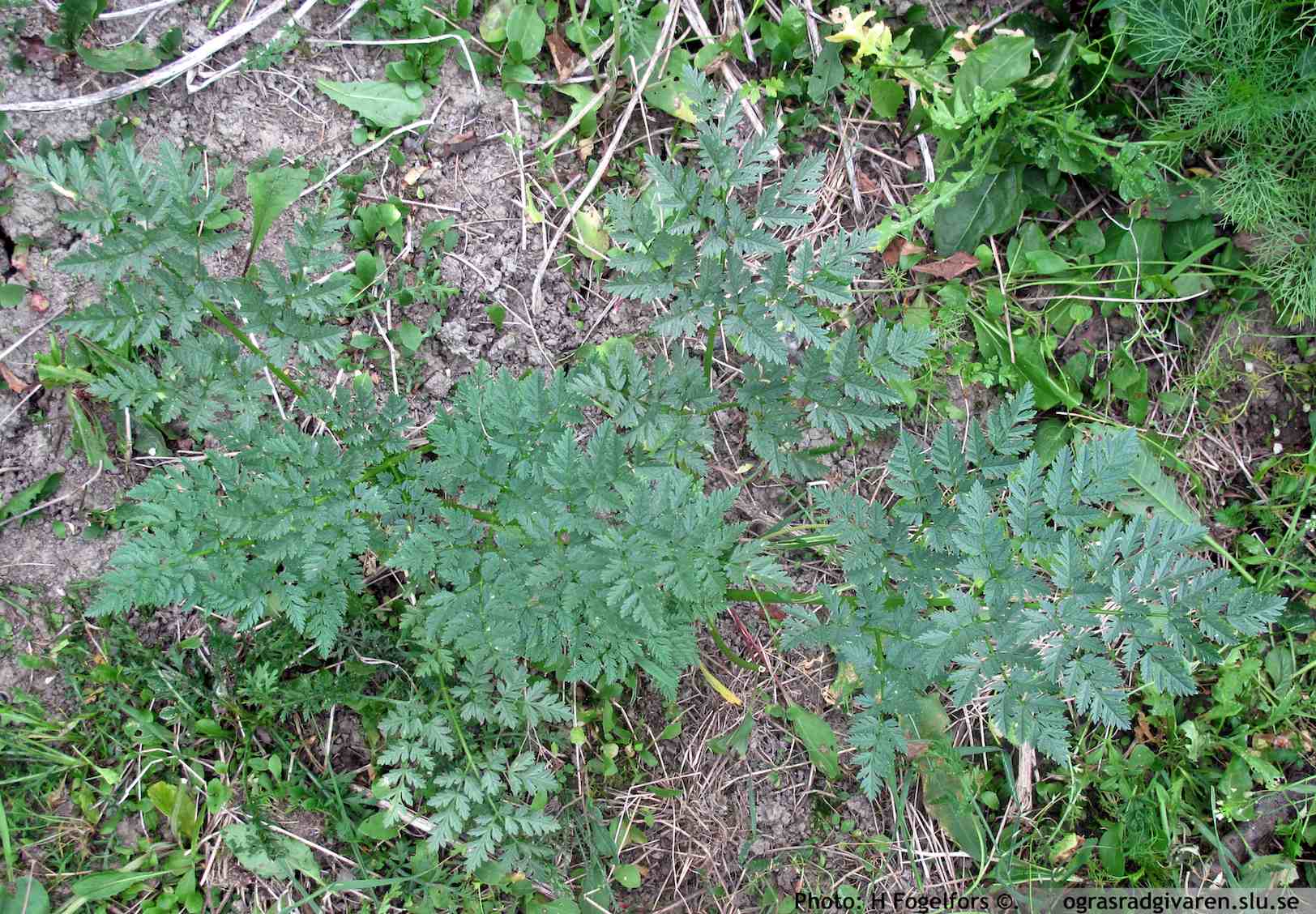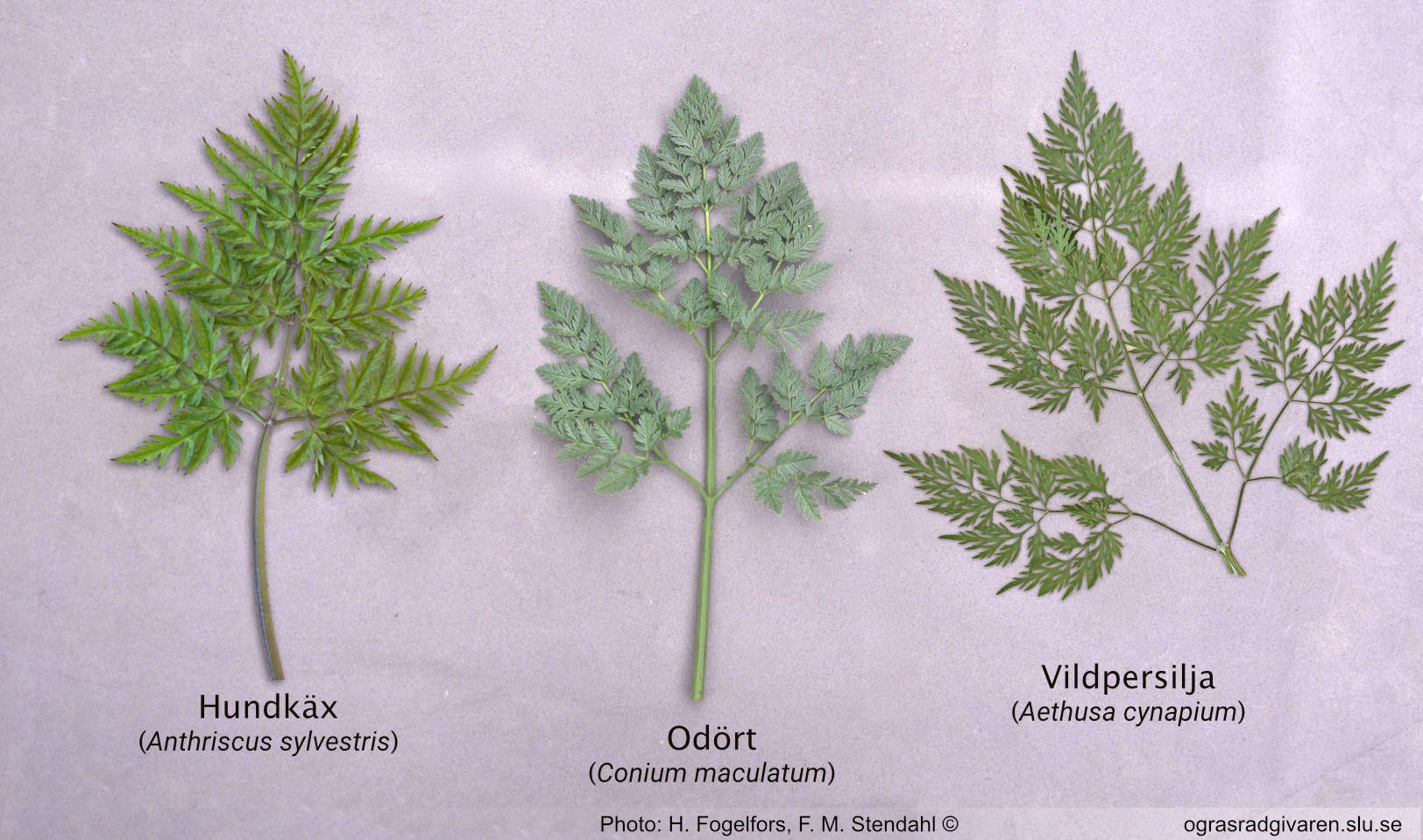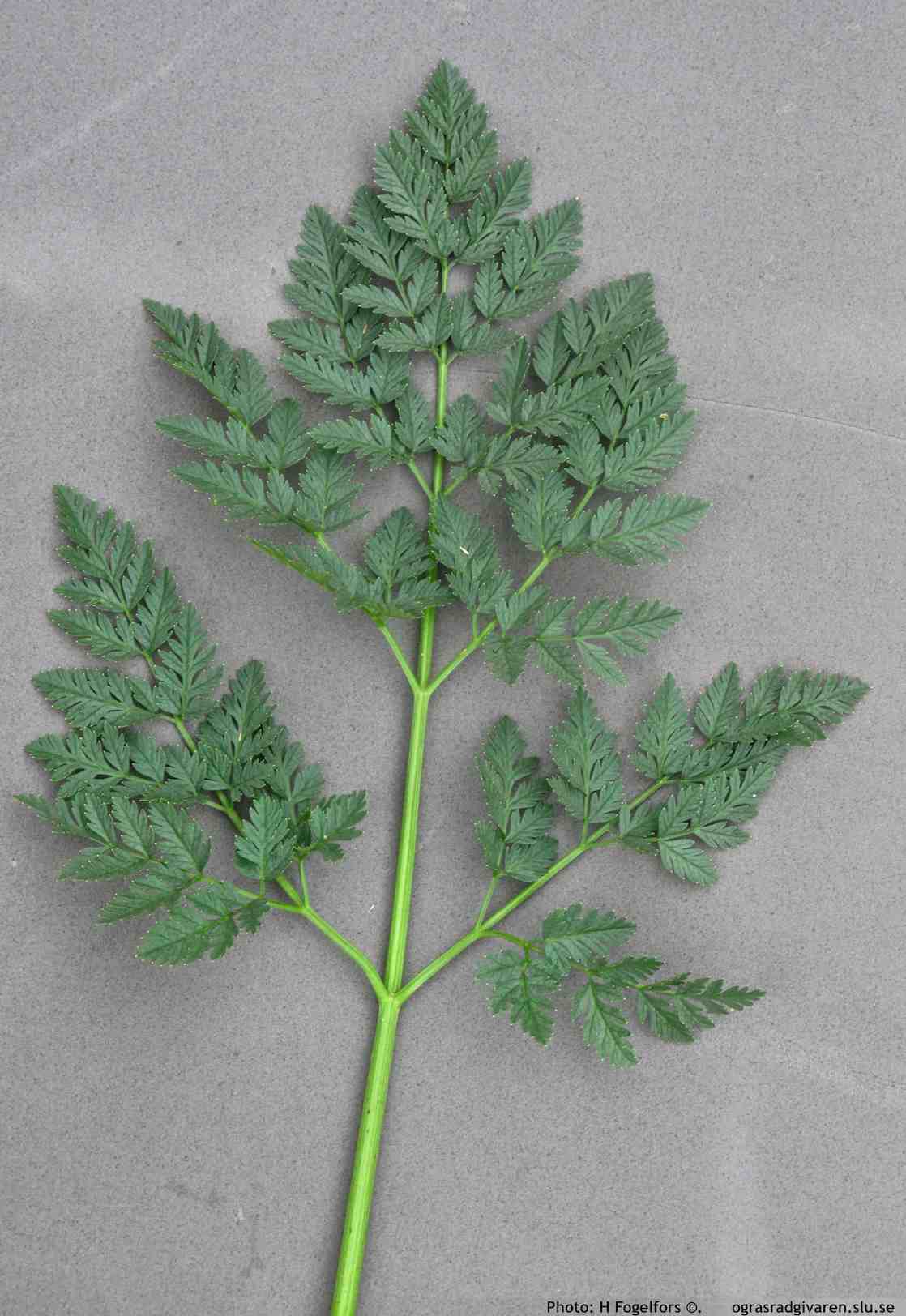Hemlock
(Conium maculatum L.) Fam:. Apiaceae
![]() Skarntyde,
Skarntyde,
![]() Täpiline surmaputk,
Täpiline surmaputk,
![]() Myrkkykatko,
Myrkkykatko,
![]() Óðjurt,
Óðjurt,
![]() Plankumainais suņstobrs,
Plankumainais suņstobrs,
![]() Kartusis kietis,
Kartusis kietis,
![]() Giftkjeks,
Giftkjeks,
![]() Болиголов крапчатый,
Болиголов крапчатый,
![]() Gefleckter Schierling ,
Gefleckter Schierling ,
![]() Odört
Odört
Tips on direct control measures based on life form
Contents:
Seedlings and small plants irrespective of life form
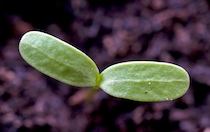
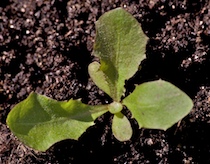
Control possibilities:
- Reduce the seed reserves in the soil either by creating a false seedbed, which involves harrowing or raking once or several times at 10-14 days before sowing so that weed seeds are stimulated to germinate; or by delayed sowing. This involves spring tillage and sowing 1-3 weeks later than the normal date, so that weed seeds that germinate early have time to germinate and develop seedlings before seedbed preparation. Trying to reduce the weed seed reserves in the soil in this way can be a very good idea if weeds have been very abundant in the previous year, especially if use of herbicides is not possible.
Another option is try to stimulate as few seeds as possible to germinate by disturbing the soil as little as possible, so that seeds buried deeper in the soil do not make contact with the sunlight in the ’germination zone’, which for most species is the upper 2-3 cm layer of the topsoil (for more information click here).
- Weed by hand or use a suitable implement so that all emerged weed plants are destroyed. This should be done at 2-3 week intervals for at least 4-6 weeks after sowing, i.e. around midsummer in Central Sweden. During the remainder of the growing season it can then be sufficient to ensure that no weed plants are allowed to flower and set seed, provided that no perennial weeds are present. These will otherwise develop vegetative reproductive structures, e.g. runners. However, in order to provide the conditions for maximum yield, all weeds should be removed every 3 weeks right up to harvest.
- Stubble cultivation (for more information click here).
- Row or weed hoeing (for more information click here [link currently not active]).
- Weed harrowing (for more information click here).
- Mulching so that weed seeds lying on the soil surface do not receive the light stimulus they need to germinate, and so that weed seedlings that have already emerged are starved out due to interrupted photosynthesis (for more information click here)
- Flaming with a gas burner kills small plants, primarily by causing surface cells in the leaves to burst, which means that the plant dries out and dies within a few days (for more information click here).
- Chemical weed control is in Sweden regulated by the Environmental Protection Agency’s rules on the use of pesticides (SNFS 1997:2). Domestic gardeners should always try to be very restrictive in their use of herbicides, since the distance between flowerbeds and vegetable plots etc. is often small, which increases the risk of effects from wind drift or transfer of the herbicides in the soil through root contact with plants in the treated plant stand, often with disastrous consequences. Despite this, if it is sometimes considered essential as a last resort to use a chemical herbicide in this situation, it should be applied as a spot treatment by stroking it on or using a backpack sprayer (for more information click here).
Young plants and older plants
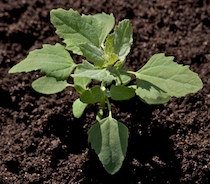
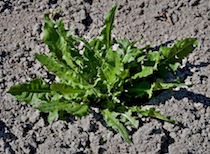
A. Annual and biennial plants (grasses and herbaceous plants)
- Hand weeding. If there has not been time to remove weed plants, then at least the flower stalks should be topped or clipped to prevent new seed being produced. Throw the heads in the rubbish bin to be sure. The compost heap is not a reliable option, since the heat in many composts is not sufficiently high to kill weed seeds.
Larger weed plants with strong roots are best pulled (or levered) out when the soil is moist, while the best time for hacking and hoeing is in dry conditions so that the remaining plants dry out and die. Unlike the roots of pulled annuals, the roots of perennials left in the soil can in some cases develop new plants from nodes on root segments (for more information click here).
- Soil tillage should be performed with a suitable implement so that the plants are destroyed and are prevented from flowering and setting seed in the following growing season (for more information click here).
- Row or weed hoeing (for more information click here [link not active]).
- Weed harrowing (for more information click here).
- Mulching so that the plants have difficulty in developing or starve to death (for more information click here).
- Weed topping. This must be done before flowering so that the plants do not have time to set seed (for more information click here).
B. Perennial species (grasses and herbaceous plants)
- Hand weeding. Dig up the first plants that appear in the garden or other environment where they have not been encountered before. Vigilance at this stage can save a lot time and effort in the future.
- Mulching so that the plants have difficulty in developing or starve to death (for more information click here).
- Soil tillage gives the best effect, since almost all species are sensitive to this type of disruption. This can be a question of stubble cultivation, deep ploughing, or shallow ploughing similar to the skim ploughing of olden days. A power cultivator or rotavator can also be used on the weed-infested surface before ploughing deeply and uniformly (for more information click here).
- Stubble cultivation (for more information click here).
- Ploughing (for more information click here).
- Chemical weed control is in Sweden regulated by the Environmental Protection Agency’s rules on the use of pesticides (SNFS 1997:2). Domestic gardeners should always try to be very restrictive in their use of herbicides, since the distance between flowerbeds and vegetable plots etc. is often small, which increases the risk of effects from wind drift or transfer of the herbicides in the soil through root contact with plants in the treated plant stand, often with disastrous consequences. Despite this, if it is sometimes considered essential as a last resort to use a chemical herbicide in this situation, it should be applied as a spot treatment by stroking it on or using a backpack sprayer (for more information click here).
- Weed topping should be carried out repeatedly when the weed plants have reached their compensation point. In any event, during the growing season the weeds must be cut before flowering to prevent them from producing seed (for more information click here).
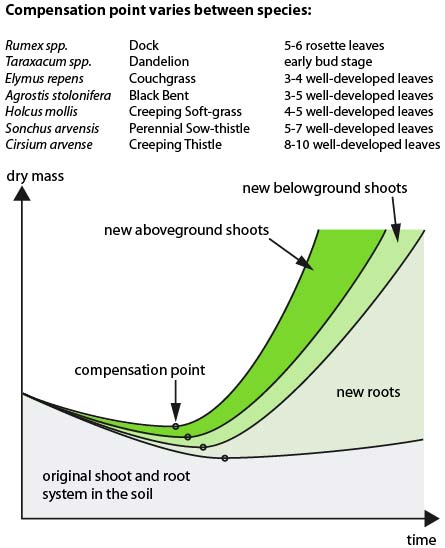
Schematic diagram of compensation point. Perennial vegetative weeds can be starved out by frequently removing the aboveground parts of the plant. This forces the plant to use its reserve nutrients in its belowground parts to produce new photosynthesising leaves. At the compensation point for the plant, the stored energy in the belowground parts is at a minimum. Therefore the best weed control effect is achieved if the weeds are disturbed every time this point is reached. The effect is enhanced if the control measure is followed by ploughing/cultivating to bury the chopped up plant runners. This means that the plant has to use up additional energy to reach the soil surface (see also the diagram below).
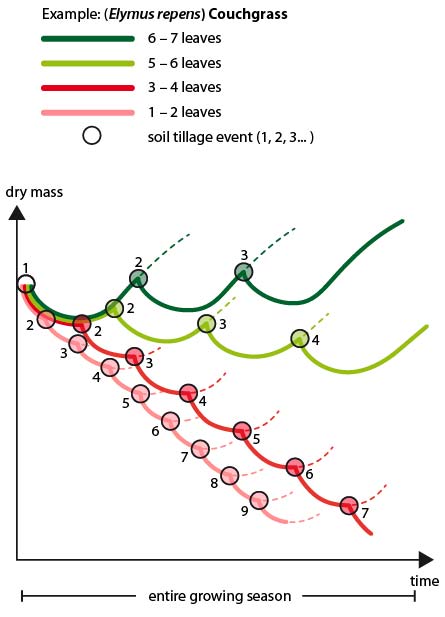
Example of how couchgrass can be controlled by applying control measures in relation to the compensation point of the plants (3-4 leaves).
C. Woody plants
These consist almost exclusively of seed plants and root shoots from bushes and trees that can appear in lawns and flowerbeds. Raspberry (Rubus idaeus), ash (Fraxinus excelsior) and aspen (Populus tremula), cherry and plum etc. (Prunus spp.) belong to this group, as does bittersweet or woody nightshade (Solanum dulcamara).
Control opportunities
In flowerbeds and vegetable plots, it is best to use a sharp spade to dig out young plants growing from seed or shooting from roots. As regards root shoots, these must be removed every year as long as the trees and bushes that represent the mother plant remain in place. In the lawn, the lawnmower takes care of them. Before removing a tree that produces root shoots, it should first be ring-barked and then left to stand for two years. This interrupts the nutrient supply to the roots, which then die, and the tree can be taken down without new root shoots appearing.
